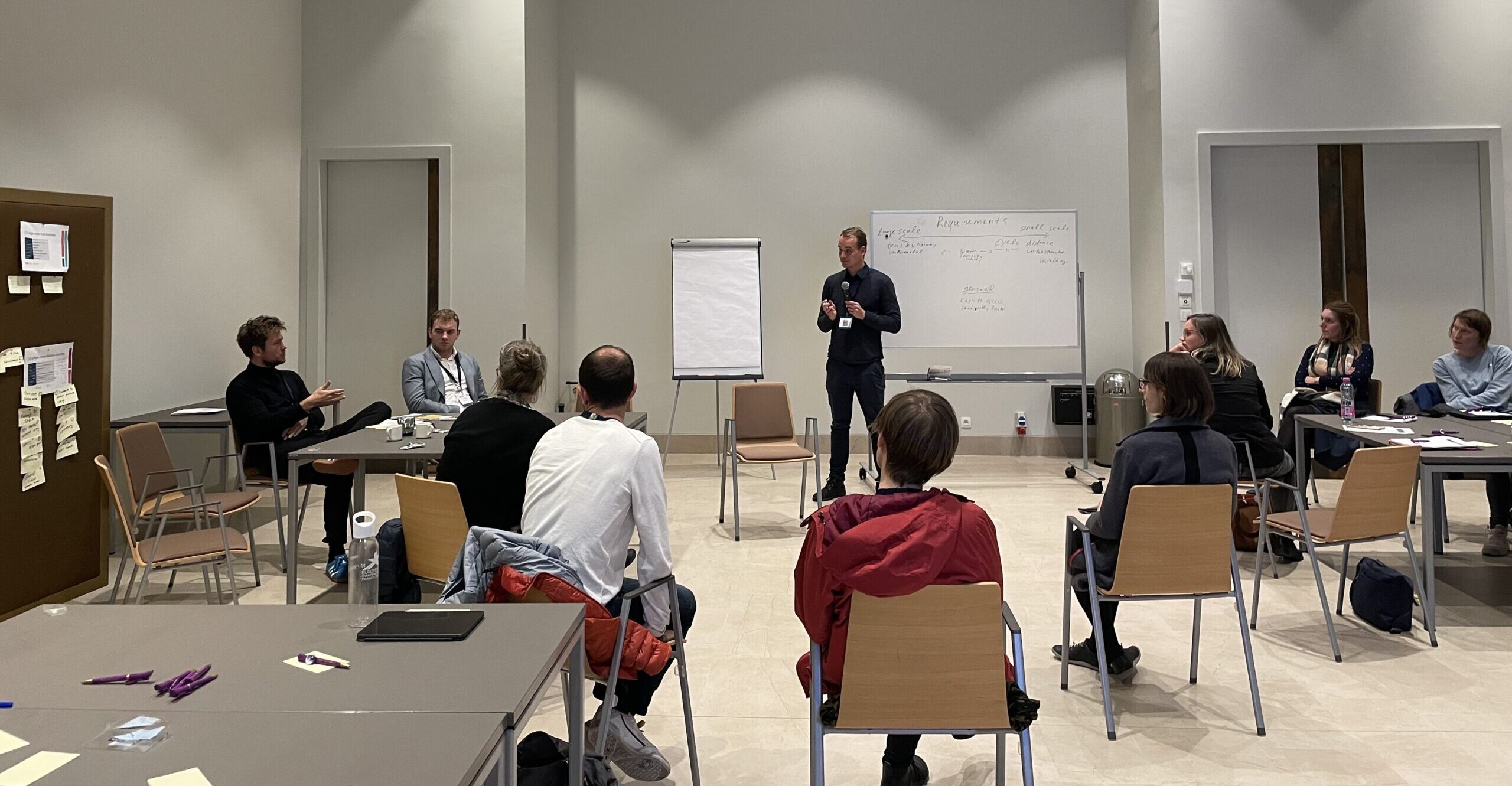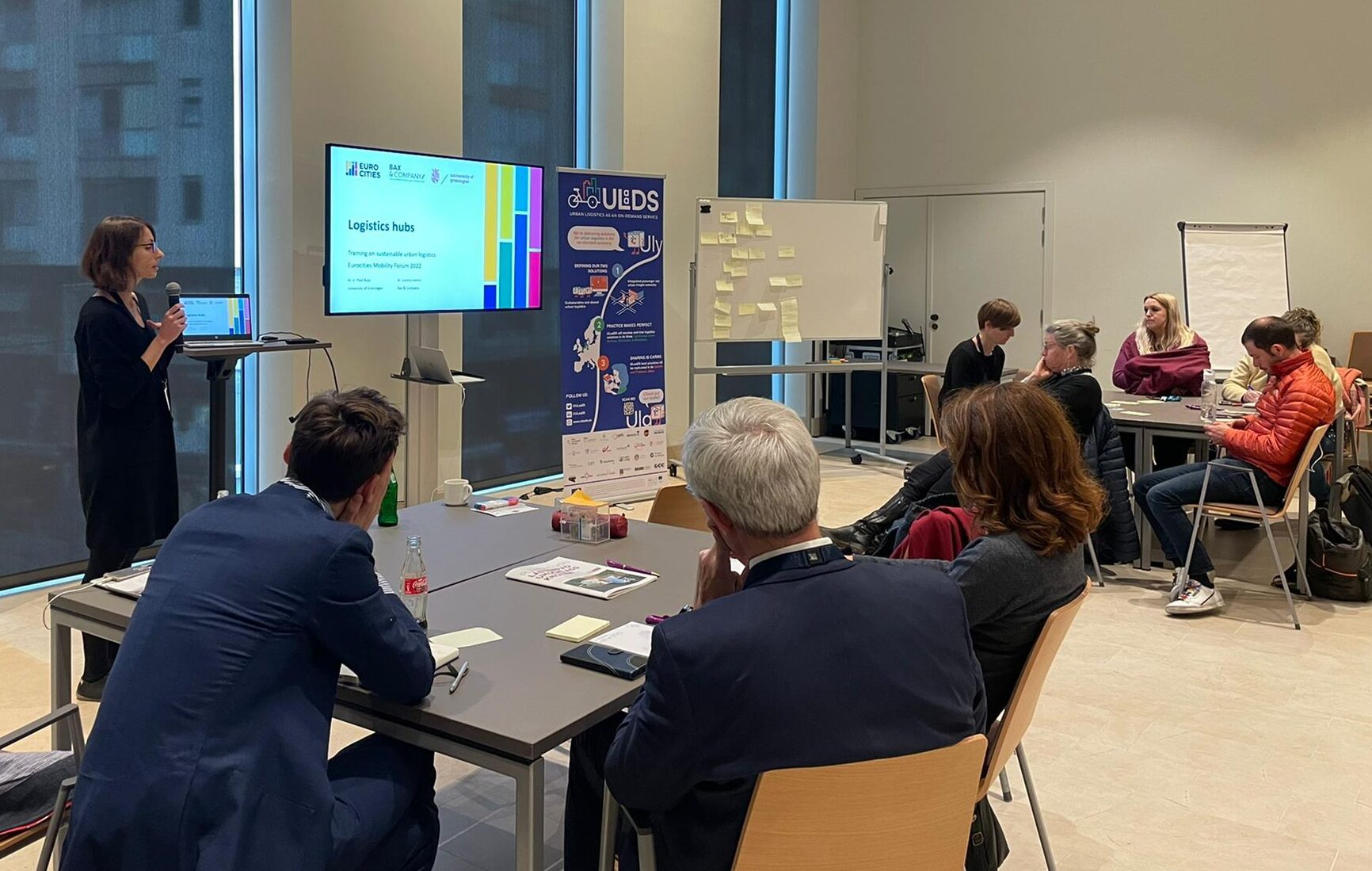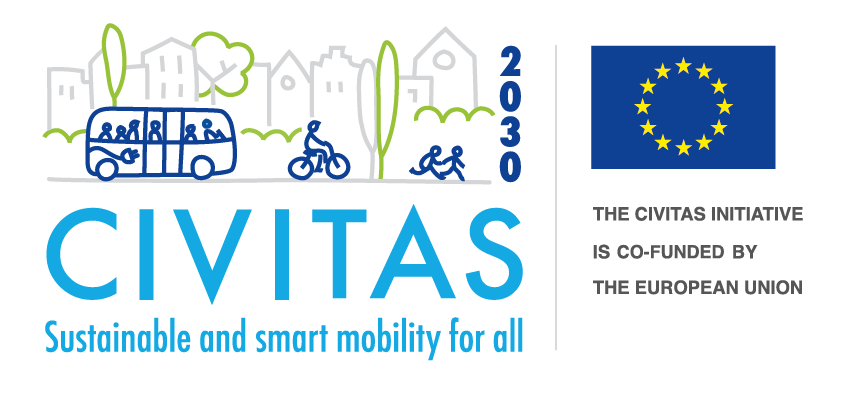Logistics hubs training at the Eurocities Mobility Forum
Logistics hubs training at the Eurocities Mobility Forum
Eurocities Mobility Forum, 17 November 2022, Antwerp
This item was first published on the Bax & Company website.
The ULaaDS project focuses on urban logistics, aiming to accelerate the integration of novel, shared and zero-emission solutions to deal with the impact of the on-demand economy. Knowledge sharing has been embedded in the project via replication activities, study visits and training sessions. The first training took the form of a workshop and was delivered during this year’s Eurocities Mobility Forum, which took place in Antwerp between 17-18 November 2022. The Forum is Eurocities’ annual event on mobility, gathering political representatives, the European Commission, local policymakers, mobility experts, and practitioners. The agenda included workshops, interactive sessions, high-level panels, site visits showcasing some of the city’s most innovative initiatives (e.g., Blue Gate Antwerp), workshops, and interactive sessions.
The ULaaDS training focused on planning logistics hubs and was co-organised by Eurocities and Bax & Company. The organisers chose this topic following a scan of the learning needs of the ULaaDS lighthouse and satellite cities. Among other topics, such as SULP development and sustainable business models for logistics solutions, public authorities expressed the need to better understand the role of logistics hubs and the best practices for planning them. To support city authorities, the workshop aimed to:
- Discuss the various steps of an integrated planning process for urban logistics hubs
- Illustrate how to define appropriate targets and objectives for hubs
- Provide a summary of the diversity of urban logistics hubs and their characteristics
- Discuss location requirements and tools to find appropriate spaces for logistic hubs
- Offer an overview of the evaluation methods of urban logistics hubs
The workshop was structured in two sessions, mixing presentations with group work and interactive parts. Read some of the main takeaways below:
- The workshop highlighted the increasing need for cities to understand the different types of urban logistics activities and flows. This knowledge would enable them to design suitable interventions towards sustainable urban logistics, including supportive and restrictive policies.
- While previously logistics were relegated to outer or industrial areas, the development of a wide variety of hub typologies is now visible in both city centres and beyond. The scale of a hub is often linked to its location, resulting in distinct requirements needed for its functioning. For example, large hubs in outer areas require good connections to highways, railways infrastructures and waterways, while microhubs in city centres need to be connected to safe cycling infrastructure to enable deliveries with cargo bikes.
- Next to the diversity in hub typologies, the variety in B2B and B2C logistics flows also determines the requirements for the effective planning of hubs. As well as parcel and HoReCa (hotel, restaurant and catering) deliveries, urban logistics flows also include construction logistics, waste management, and service logistics (e.g., cleaning).
- The most robust business case for consolidation exists for low-density carriers, who traditionally have only one or two stops in a city, such as HoReCa or medium-sized retailers. These carriers lack the necessary volumes for efficient deliveries but make up the largest share of the total driven kilometres. Concerning the number of hubs, a one-tier consolidation system suffices in most municipalities. Only in larger cities, a two-tier system that combines an urban consolidation centre with microhubs at the neighbourhood level makes sense from an economic point of view.
- Several potential locations for logistics hubs exist, among which are parking lots and garages, empty retail stores, brownfield areas, and public transport depots. Besides, existing buildings can be expanded vertically, helping to increase density and reduce soil sealing.
- Cities can introduce both supportive (e.g., financial incentives) and restrictive (e.g., low-emission zones) policies to guide the development of urban logistics hubs, influencing their location and other characteristics.
- In terms of project evaluation, cities can support urban logistics hubs by evaluating them based on the potential for improvement and/or scaling up. Some of the methods include traffic flow simulation, air pollution simulation, air pollution measurements, vehicle counting, noise measurement or public surveys. The method chosen depends on the situation and the focus of the evaluation.
The training materials for planning logistics hubs are available to download below. The slides include a presentation of the planning process for urban logistics hubs, as well as a typology of different hubs with various examples.
Training for Urban Logistics Hubs by Dr Tom Assmann from Otto-von-Guericke-Universität Magdeburg
Planning Chart for Hubs by Dr Tom Assmann from Otto-von-Guericke-Universität Magdeburg
Understanding Logistics Hubs by Dr Lorena Axinte from Bax & Company and Dr. ir. Paul Buijs from University of Groningen
The workshop was facilitated by Arianna Americo (Eurocities), led by Dr. Tom Assmann (Otto von Guericke University Magdeburg), and had contributions from Dr. Lorena Axinte (Bax & Company) and Prof. Joris Beckers (University of Antwerp). The content was based on findings from:
- Cargo Bike Depot / CityChangerCargoBike – Planning of cargo bike hubs
- ULaaDS D3.1: Benchmarking business/operating models and best practices
- R!sult project
The next training session will take place during the Eurocities Mobility Forum 2023, in Porto. Keep an eye on the ULaaDS website and follow our Twitter and LinkedIn profiles to stay updated.





